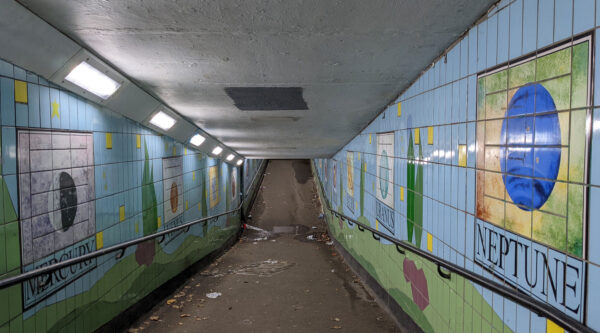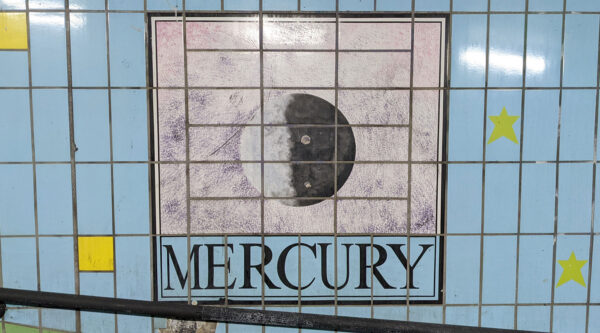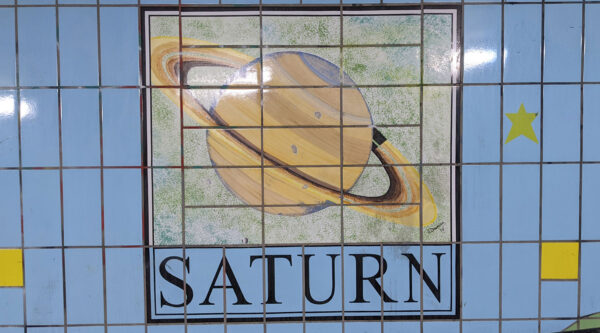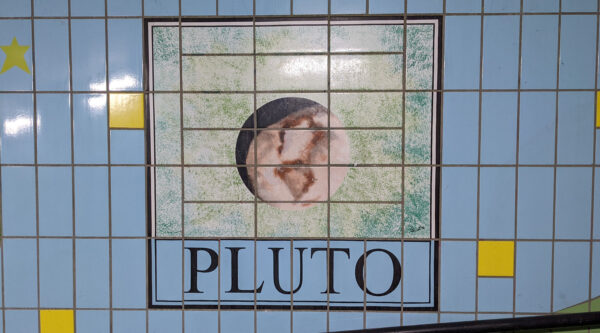This is a subway under a busy road in Mill Hill Broadway that has two claims to fame, and the most obvious is that it’s decorated with images of the solar system.
The subway is lined with what might be considered classic municipal subway tiles of blue and green, but what is very noticeable are the large murals of all of the planets and the sun that line the subway. Twice in fact, as they’re mirrored on each wall.
Uranus is shown with its rings, which are vertical as the planet spins sideways compared to all the other planets in the Solar System. Venus, a cloud covered planet is shown without its clouds, based on radar scans from spacecraft that were sent to orbit the planet. The Earth is shown with the Atlantic ocean in the centre, so you can see most of Europe, Africa and South America — this is not an American centric image of our planet.
Somewhat bravely, Pluto was added before there had been any decent photos of the surface taken, but when the New Horizons spacecraft visited in 2015, the artist would have been reassured to know they wouldn’t be asked to come back and make corrections – it’s quite a good estimate of what the planet looks like.
However, one of the two murals of Pluto has had “not a planet” scratched into the decoration, although they didn’t do the same for the sun, which unless something catastrophic happened, is also not a planet.
The choice for the decoration can be attributed to a nearby organisation, the UCL Observatory which is a few minutes walk away. It’s proven remarkably difficult to find out much else about the decoration though. The murals are by two artists, S Burnett and J Deardey (spelling unclear).
The subway is significant for more than the recent decoration though — it’s the very first subway built in the UK under a major road.
The road needed something because on one side was housing, but on the other was a large public park that the local council had bought in 1923 for the area, but when the Watford Way bypass was built in 1928, it cut the town from the park, and people were forced to cross the road at street level dodging the cars. The Hendon & Finchley Times said that pedestrians could wait up to half an hour at busy times for a gap to appear in the road traffic.
After some effort, the council was able to secure half the cost of building a subway from the government, and construction started in August 1936, and formally opened in July 1937 by the newly appointed Minister of Transport, Leslie Burgin MP. The Minister arrived late, because of road congestion.
“This subway,” he said, “was the first of its kind under a trunk road, and, to his mind, this method has its advantages. It was comparatively inexpensive, for the fly-over bridge was an enormously expensive project. This idea of driving a rabbit burrow underneath was a moral to follow in other parts of the country”
The subway was built out of reinforced concrete and was also one of the earliest to be built with both steps and ramp access. The ramp was an experiment to see if people would swap from crossing the road and use the subway because it had been found at the time that people wanted to avoid the stairs when pushing prams or elderly.
The subway was seen as being an experiment and having proven to be a success in reducing road accidents, subways were built across the country. However, over the past couple of decades, many of them are being filled in. A lack of maintenance meant they were often damp and dirty, and thanks to their secluded location, a home for the homeless or a toilet for the desperate. Pedestrians took to crossing roads at street level again, and councils are now putting in pedestrian crossings and closing subways.
The principle that nothing should be allowed to impede the passage of the motor car is over.



















For the past 3 years I’ve been a regular reader of articles on this excellent site.
I am familiar with this ‘story’ as I spent my childhood in 1950s/60s living within a few minutes walk of the Watford by-pass. Also my father had lived in the area since the early 1930s.
I am pretty sure that you are conflating two subways across the road.
The 1930s tunnel was built a few hundred yards towards Hendon and was built solely to join the 2 sections Mill Hill Park which had been severed when the 3 lane bypass was built in the late 1920s (the middle lane was ‘shared’ by traffic in both directions and it was the fastest road for miles around) It also provided direct and safe access to Mill Hill Swimming Pool which was particularly important for children of LCC’s Burnt Oak estate. The tunnel had no need for steps, only needing a gentle slope at each end, and any access from the road was an ‘afterthought’. It was shaped like a mini tube tunnel and the tiling was dark green. Though there was no lighting, as a child, it seemed perfectly safe in daylight.
According to local press articles I gather that has the tunnel opening been delayed by a few months it would have been opened by the former Minister of Transport, Mr Belisha!
Around 1960 the road was widened to dual carriageway, as it is now. This is when the tunnel,in the images, was built being mainly for people going to the Broadway shops, library plus access to the Swimming Pool from the Broadway. I recall its construction, like the article says it was quite controversial. I hardly ever used it. It felt quite spooky, not safe and not particularly clean, compared with the tunnel in the park I much prefered using one of Belisha’s two crossings close to Mill Hill Circus, just one or two minutes away.
I remember using that subway in the mid 90s and it wad quite scary to be honest, it was like the ones in Elephant and Castle, it’s good to see that they have invested in this one which is still needed. Subways and the Thames foot tunnels are useful and still necessary but they need to look after them and nobody seems to want to.
In Elephant and Castle they got rid of the subways and put in pedestrian crossings but I see a lot of people running and dodging traffic instead of waiting for the Green signal and a lot of them kids so we will see if the Subways really were the answer. Of course if you’re Southwark Council, you don’t maintain anything just like the council estates and the communities they are supposed to serve.
This has been a wonderful website and the creator obviously shares the same interests as myself and shall be making a donation for the site soon.
At the other end of Mill Hill Broadway, the station has a tunnel (or subway) under the tracks which I recall being gas-lit, walking through it twice a day to and from school in the mid ’50s from Bunn’s Lane to Sylvan Avenue.
I just went through this today. Would recommend everyone to book a visit to the nearby mill hill observatory. Very interesting though it’s no longer really an active observatory and more of a teaching aid.
Thanks for this article on a neighbourhood and thus subway I know nothing about. I did read your fairly recent article on the UCL observatory but missed out on some of the events they were running. I agree that subways need ongoing maintenance and it feels like to maintain a feeling of safety and relative cleanliness, cheerful murals like this help with that.
Reading the comments above, for some reason, I didn’t actually know the Elephant and Castle subways had been closed but then I have used the recent pedestrian crossings so I should know this! I used to live in southeast London and have memories of navigating E&C subways after club closing time. They were frightening but yet I always had a feeling of success when I navigated them successfully and without being approached or catcalled and got up above ground to my bus stop. Oh dear.
“The principle that nothing should be allowed to impede the passage of the motor car is over.” – I really hope this is the case.
I used the Watford Way tunnel frequently as a child and can confirm both the green tiling and the lack of steps. What hasn’t been mentioned is that there were lengths of old tramway track, about 4 feet high, inserted vertically outside the entrances to stop people cycling (or driving!) through.
I can also confirm the gaslit subway at Mill Hill Broadway station (in fact the entire station was lit by gas), however this isn’t the present subway which was built in the early 1960s when the old station was demolished and the present one built.
I was born 1946 & my family moved to 476 Watford Way in the 1950’s (opposite “K” Garage) on the main A41 from Fiveways Corner towards Mill Hill.
Growing up, I Experienced a huge number of massive crashes on the main road and many times I was awaken at 03:00 hours by another vehicle “ accident“, with people taken from sleep rushing to help others trapped in vehicles.
I Worried constantly about my father getting off the bus at five ways corner from a # 113 bus and trying to cross the road to access our house on the other side.
a Subway was eventually built at ‘fiveways’ much to us kids relief.
However, further up heading to Mill Hill at the 113 bus stop ,to cross to houses on the other side (Tithe walk and Tithe Close) people had to take their life in their hands , as they did so later with the death of five people trying to get access to their homes.
There seems to be little sad about this terrible accident but a subway was subsequently built, many of my neighbours had died.
Luckily I missed this terrible scene as my dad said at the time he had experienced it and it looked like a battlefield (he served in the Second World War) I was at Mill Hill swimming pool and returned any later.
Any comment is more than welcome as we live miles away now in another country and I miss,(it’s hard to believe but) the “Hairy” childhood I experienced.
Ps I now know how to administer first aid!